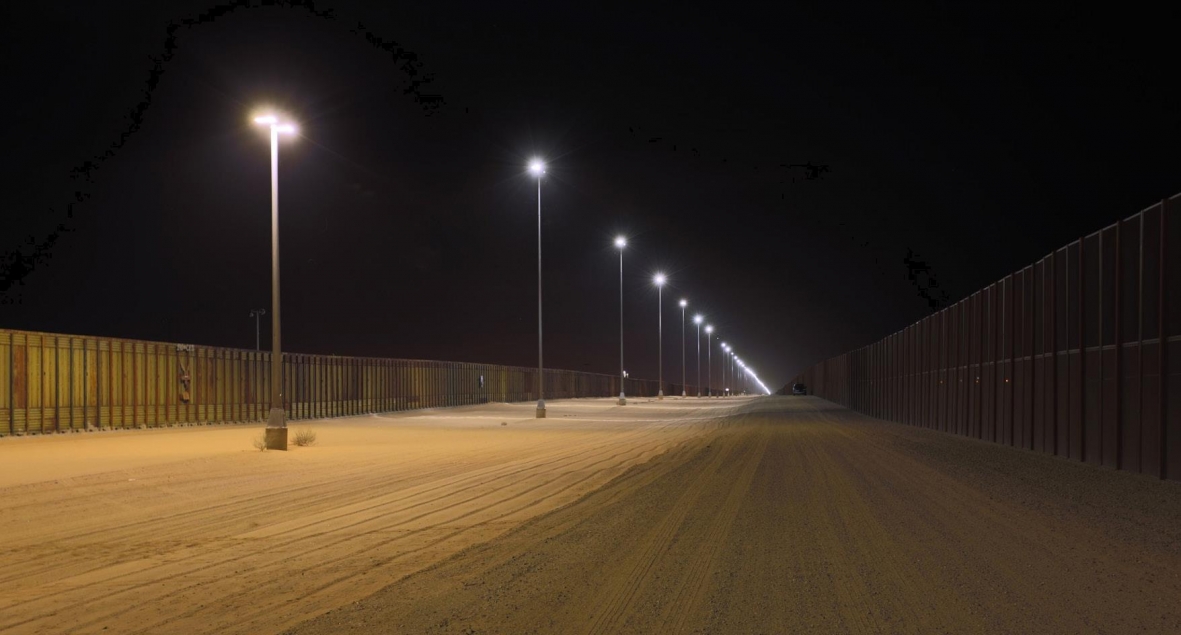The Department of Energy (DOE) has released the final report in a series documenting the performance of high-flux LED lighting in a high-temperature environment over a period of almost four years. High-flux lighting applications include high-security exterior lighting (such as correctional facilities and military bases) as well as street and area lighting. In high-temperature environments, such applications present a formidable challenge for LEDs.
To learn more about how this type of environment affects LED lumen and color maintenance, luminaire efficacy, and luminaire component lifetimes, DOE’s GATEWAY program documented the LED retrofit of the incumbent quartz metal halide (QMH) area lighting along a 7.2-mile stretch of the Yuma, Arizona, Sector Border Patrol Area between the U.S. and Mexico, where temperatures at sunset can exceed 100° F.
Taking the Heat
In February 2014, two LED luminaires were installed on each of three sequential poles as a trial installation of the proposed design solution. Illuminance measurements were recorded initially upon installation, then again in September 2014 at 2,500 hours of operation, in March 2015 at 5,000 hours of operation, in September 2015 at 7,000 hours of operation, and in September 2016 at 11,000 hours of operation. Additionally, four second-generation LED luminaires installed as part of the full installation in September 2016 were evaluated initially and again in August 2017 after 4,000 hours of operation.
The LED lighting systems installed in Yuma provided substantial benefits in energy reduction, lighting uniformity, and maintenance savings compared to the incumbent system. Reductions in light output due to dirt depreciation during the initial operating period (7,000 hours for the first-generation luminaires and 4,000 hours for the second generation) were similar to those predicted using Illuminating Engineering Society luminaire dirt depreciation estimation methods, and were similar to those reported for several other LED systems evaluated by the GATEWAY program.
Illuminance levels produced by the first-generation luminaires decreased dramatically between 7,000 and 11,000 operating hours. The measured illuminance of these luminaires in a clean state at 11,000 hours was found to have decreased by more than 50% compared to initial measurements after installation. The cause for this is not yet known and may be related to the unique conditions of the trial installation of first-generation luminaires, but the high-temperature environment may also have contributed.
The Second Generation
Over 4,000 hours of operation, the measured spectral power distributions (SPDs) and related color characteristics for the second-generation luminaires changed to a greater extent than expected. The high-temperature environment in Yuma may have caused, or at least contributed to, these effects, although luminaire design characteristics can also contribute to accelerated shifts in SPD.
The second-generation luminaires exhibited color-over-angle variability that produced noticeable color differences on the illuminated sand beneath the system. Determination of SPD and related color metrics at different angles is not currently included in standardized luminaire photometric testing. This type of variability may not be as noticeable in other applications, but the Yuma result demonstrates that as solid-state lighting (SSL) technology continues to evolve, the nature and the extent of the data that product developers, manufacturers, and specifiers need in order to evaluate the performance of products and systems are also changing. The development of relevant testing and reporting procedures and metrics of acceptability necessarily lags behind the identification of the need for certain types of data.
A Gap between Lab and Field Performance
The results from the Yuma GATEWAY evaluation highlight the gap that still exists between laboratory-based performance testing of LED lighting products and systems, and their performance in the field. While standard test methods such as LM-80, and defined calculation techniques such as TM-21 and TM-28, provide a critical part of the information needed for SSL, the results from this project show that system and field application conditions can make it difficult to predict installed performance over time. These predictions are likely more difficult in extreme conditions, such as those encountered in the Yuma evaluation.
While the initial energy, lighting quality, and maintenance benefits relative to the incumbent system were well documented and produced very satisfactory results for Customs and Border Protection, the evaluation raises questions regarding the long-term performance of LED lighting systems in high-temperature environments. Ongoing improvement of current test methods and standards for LED luminaires, as well as new approaches to product and system development, are needed to improve performance of LED lighting systems.
Tagged with Department of Energy, lightED